deactivate passenger airbag SKODA OCTAVIA 2010 2.G / (1Z) Owner's Manual
[x] Cancel search | Manufacturer: SKODA, Model Year: 2010, Model line: OCTAVIA, Model: SKODA OCTAVIA 2010 2.G / (1Z)Pages: 275, PDF Size: 16.43 MB
Page 144 of 275
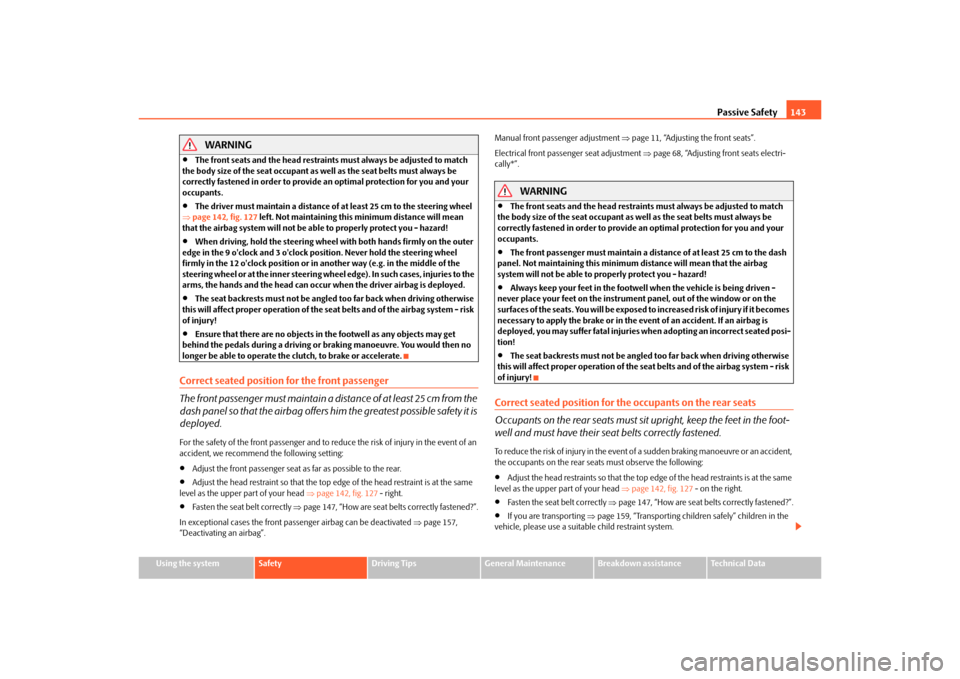
Passive Safety143
Using the system
Safety
Driving Tips
General Maintenance
Breakdown assistance
Technical Data
WARNING
The front seats and the head restraints must always be adjusted to match
the body size of the seat occupant as well as the seat belts must always be
correctly fastened in order to provide an optimal protection for you and your
occupants.
The driver must maintain a distance of at least 25 cm to the steering wheel
page 142, fig. 127 left. Not maintaining this minimum distance will mean
that the airbag system will not be able to properly protect you - hazard!
When driving, hold the st eering wheel with both hands firmly on the outer
edge in the 9 o'clock and 3 o'clock po sition. Never hold the steering wheel
firmly in the 12 o'clock position or in another way (e.g. in the middle of the
steering wheel or at the inner steering wheel edge). In such cases, injuries to the
arms, the hands and the head can occur when the driver airbag is deployed.
The seat backrests must not be angled too far back when driving otherwise
this will affect proper operation of the se at belts and of the airbag system - risk
of injury!
Ensure that there are no objects in the footwell as any objects may get
behind the pedals during a driving or braking manoeuvre. You would then no
longer be able to operate the clutch, to brake or accelerate.
Correct seated position for the front passenger
The fro n t p assen ger must mai n tai n a d i stan ce of a t l ea st 25 c m from th e
dash panel so that the airbag offers him the greatest possible safety it is
deployed.For the safety of the front passenger and to reduce the risk of injury in the event of an
accident, we recommend the following setting:
Adjust the front passenger seat as far as possible to the rear.
Adjust the head restraint so that the top edge of the head restraint is at the same
level as the upper part of your head page 142, fig. 127 - right.
Fasten the seat belt correctly page 147, “How are seat belts correctly fastened?”.
In exceptional cases the front pass enger airbag can be deactivated page 157,
“Deactivating an airbag”. Manual front passenger adjustment
page 11, “Adjusting the front seats”.
Electrical front passenger seat adjustment page 68, “Adjusting front seats electri-
cally*”.
WARNING
The front seats and the head restraints must always be adjusted to match
the body size of the seat occupant as well as the seat belts must always be
correctly fastened in order to provide an optimal protection for you and your
occupants.
The front passenger must maintain a distance of at least 25 cm to the dash
panel. Not maintaining this minimum distance will mean that the airbag
system will not be able to properly protect you - hazard!
Always keep your feet in the footwel l when the vehicle is being driven -
never place your feet on the instrument panel, out of the window or on the
surfaces of the seats. You will be exposed to increased risk of injury if it becomes
necessary to apply the brake or in the ev ent of an accident. If an airbag is
deployed, you may suffer fatal injuries wh en adopting an incorrect seated posi-
tion!
The seat backrests must not be angled too far back when driving otherwise
this will affect proper operation of the se at belts and of the airbag system - risk
of injury!
Correct seated position for the occupants on the rear seats
Occupants on the rear seats must sit upright, keep the feet in the foot-
well and must have their se at belts correctly fastened.To reduce the risk of injury in the event of a sudden braking manoeuvre or an accident,
the occupants on the rear seats must observe the following:
Adjust the head restraints so that the top edge of the head restraints is at the same
level as the upper part of your head page 142, fig. 127 - on the right.
Fasten the seat belt correctly page 147, “How are seat belts correctly fastened?”.
If you are transporting page 159, “Transporting children safely” children in the
vehicle, please use a suitable child restraint system.
s43s.1.book Page 143 Thursday, May 13, 2010 1:21 PM
Page 154 of 275
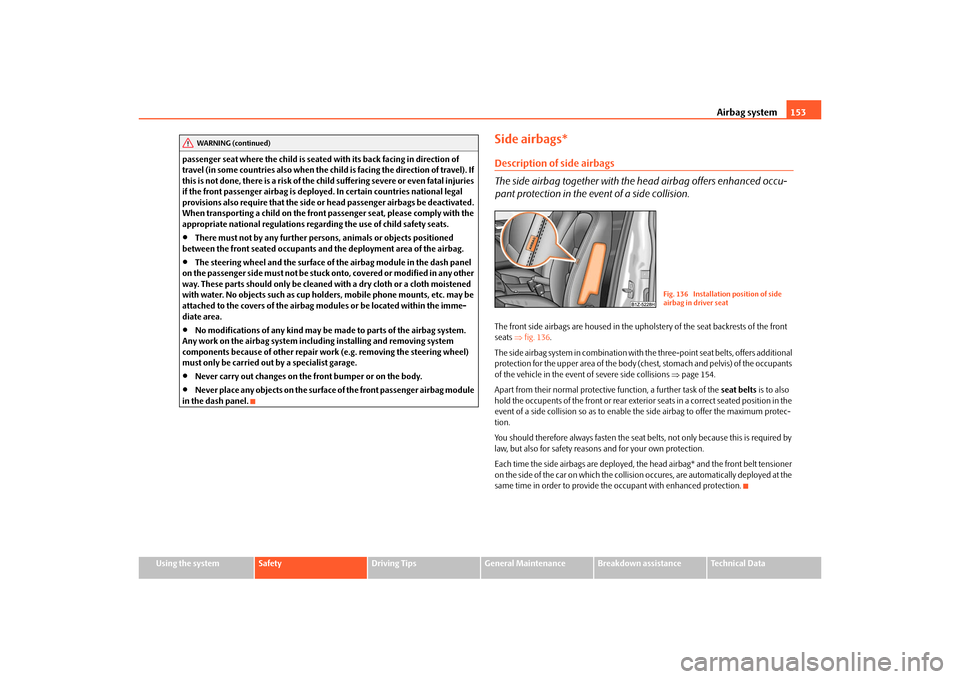
Airbag system153
Using the system
Safety
Driving Tips
General Maintenance
Breakdown assistance
Technical Data
passenger seat where the child is seated
with its back facing in direction of
travel (in some countries also when the child is facing the direction of travel). If
this is not done, there is a risk of the ch ild suffering severe or even fatal injuries
if the front passenger airbag is deploy ed. In certain countries national legal
provisions also require that the side or head passenger airbags be deactivated.
When transporting a child on the front passenger seat, please comply with the
appropriate national regu lations regarding the use of child safety seats.
There must not by any further persons, animals or objects positioned
between the front seated occupants and the deployment area of the airbag.
The steering wheel and the surface of the airbag module in the dash panel
on the passenger side must not be stuck onto, covered or modified in any other
way. These parts should only be cleaned with a dry cloth or a cloth moistened
with water. No objects such as cup holders, mobile phone mounts, etc. may be
attached to the covers of the airbag modules or be located within the imme-
diate area.
No modifications of any kind may be made to parts of the airbag system.
Any work on the airbag system includ ing installing and removing system
components because of other repair wo rk (e.g. removing the steering wheel)
must only be carried out by a specialist garage.
Never carry out changes on the front bumper or on the body.
Never place any objects on the surface of the front passenger airbag module
in the dash panel.
Side airbags*Description of side airbags
The side airbag together with the head airbag offers enhanced occu-
pant protection in the event of a side collision.The front side airbags are housed in the upholstery of the seat backrests of the front
seats fig. 136 .
The side airbag system in combination with the three-point seat belts, offers additional
protection for the upper area of the body (chest, stomach and pelvis) of the occupants
of the vehicle in the event of severe side collisions page 154.
Apart from their normal protective function, a further task of the seat belts is to also
hold the occupents of the front or rear exteri or seats in a correct seated position in the
event of a side collision so as to enable th e side airbag to offer the maximum protec-
tion.
You should therefore always fasten the seat belts, not only because this is required by
law, but also for safety reasons and for your own protection.
Each time the side airbags are deployed, th e head airbag* and the front belt tensioner
on the side of the car on which the collision occures, are automatically deployed at the
same time in order to provide the occupant with enhanced protection.
WARNING (continued)
Fig. 136 Installation position of side
airbag in driver seat
s43s.1.book Page 153 Thursday, May 13, 2010 1:21 PM
Page 155 of 275
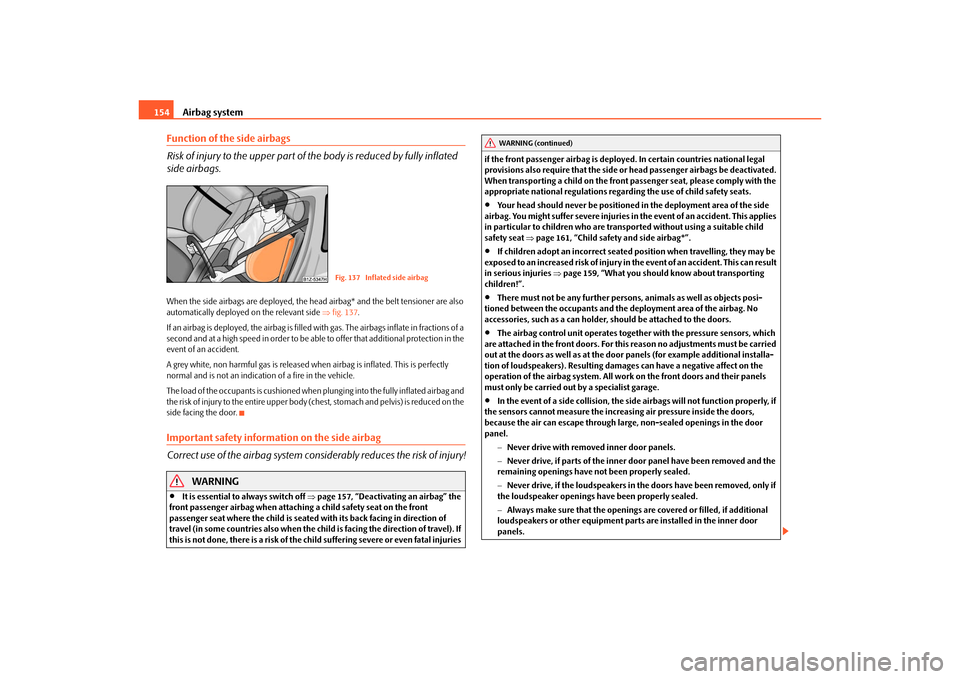
Airbag system
154
Function of the side airbags
Risk of injury to the upper part of the body is reduced by fully inflated
side airbags.When the side airbags are deployed, the head airbag* and the belt tensioner are also
automatically deployed on the relevant side fig. 137 .
If an airbag is deployed, the airbag is filled with gas. The airbags inflate in fractions of a
second and at a high speed in order to be able to offer that additional protection in the
event of an accident.
A grey white, non harmful gas is released when airbag is inflated. This is perfectly
normal and is not an indicati on of a fire in the vehicle.
The load of the occupants is cushioned when plunging into the fully inflated airbag and
the risk of injury to the entire upper body (chest, stomach and pelvis) is reduced on the
side facing the door.Important safety information on the side airbag
Correct use of the airbag system cons iderably reduces the risk of injury!
WARNING
It is essential to always switch off page 157, “Deactivating an airbag” the
front passenger airbag when attachin g a child safety seat on the front
passenger seat where the child is seated with its back facing in direction of
travel (in some countries also when the child is facing the direction of travel). If
this is not done, there is a risk of the ch ild suffering severe or even fatal injuries if the front passenger airbag is deploy
ed. In certain countries national legal
provisions also require that the side or head passenger airbags be deactivated.
When transporting a child on the front passenger seat, please comply with the
appropriate national regulations regarding the use of child safety seats.
Your head should never be positioned in the deployment area of the side
airbag. You might suffer severe injuries in the event of an accident. This applies
in particular to children who are transported without using a suitable child
safety seat page 161, “Child safety and side airbag*”.
If children adopt an incorrect seated position when travelling, they may be
exposed to an increased risk of injury in the event of an accident. This can result
in serious injuries page 159, “What you should know about transporting
children!”.
There must not be any further persons, animals as well as objects posi-
tioned between the occupants and the deployment area of the airbag. No
accessories, such as a can holder, should be attached to the doors.
The airbag control unit operates togeth er with the pressure sensors, which
are attached in the front doors. For this reason no adjustments must be carried
out at the doors as well as at the door panels (for example additional installa-
tion of loudspeakers). Resulting damage s can have a negative affect on the
operation of the airbag system. All work on the front doors and their panels
must only be carried out by a specialist garage.
In the event of a side collision, the side airbags will not function properly, if
the sensors cannot measure the increasi ng air pressure inside the doors,
because the air can escape through lar ge, non-sealed openings in the door
panel.
Never drive with removed inner door panels.
Never drive, if parts of the inner do or panel have been removed and the
remaining openings have not been properly sealed.
Never drive, if the loudspeakers in the doors have been removed, only if
the loudspeaker openings have been properly sealed.
Always make sure that the openings are covered or filled, if additional
loudspeakers or other equipment part s are installed in the inner door
panels.
Fig. 137 Inflated side airbag
WARNING (continued)
s43s.1.book Page 154 Thursday, May 13, 2010 1:21 PM
Page 157 of 275
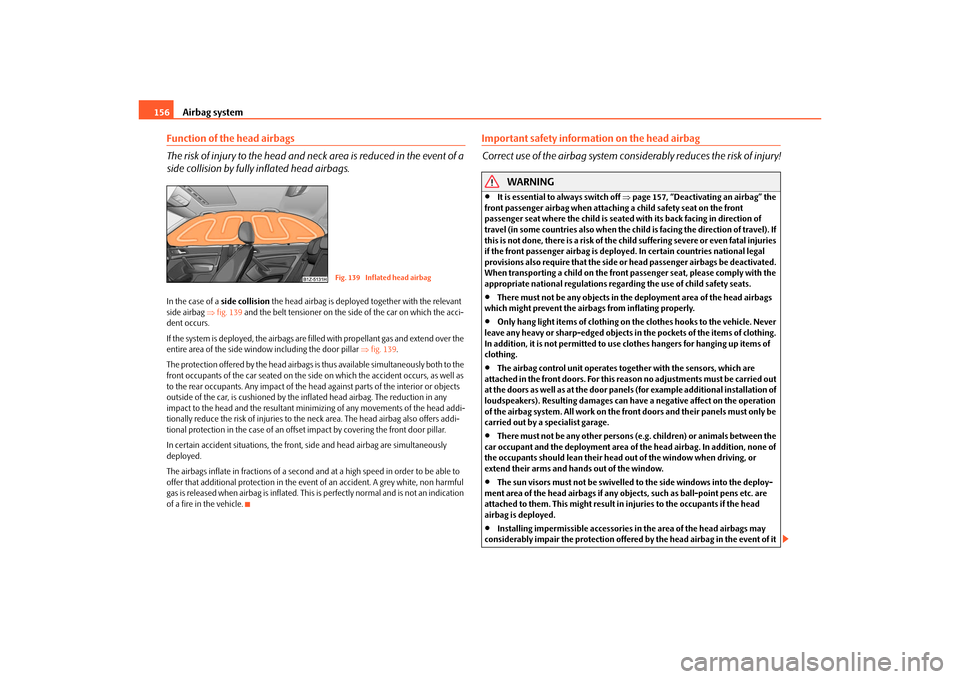
Airbag system
156
Function of the head airbags
The risk of injury to the head and neck area is reduced in the event of a
side collision by fully inflated head airbags.In the case of a side collision the head airbag is deployed together with the relevant
side airbag fig. 139 and the belt tensioner on the side of the car on which the acci-
dent occurs.
If the system is deployed, the airbags are filled with propellant gas and extend over the
entire area of the side wind ow including the door pillar fig. 139 .
The protection offered by the head airbags is thus available simultaneously both to the
front occupants of the car seated on the side on which the accident occurs, as well as
to the rear occupants. Any impact of the head against parts of the interior or objects
outside of the car, is cushioned by the in flated head airbag. The reduction in any
impact to the head and the resultant minimi zing of any movements of the head addi-
tionally reduce the risk of injuries to the neck area. The head airbag also offers addi-
tional protection in the case of an offset impact by covering the front door pillar.
In certain accident situations, the front, side and head airbag are simultaneously
deployed.
The airbags inflate in fractions of a second an d at a high speed in order to be able to
offer that additional protection in the even t of an accident. A grey white, non harmful
gas is released when airbag is inflated. This is perfectly normal and is not an indication
of a fire in the vehicle.
Important safety information on the head airbag
Correct use of the airbag system cons iderably reduces the risk of injury!
WARNING
It is essential to always switch off page 157, “Deactivating an airbag” the
front passenger airbag when attaching a child safety seat on the front
passenger seat where the child is seated with its back facing in direction of
travel (in some countries also when the chil d is facing the direction of travel). If
this is not done, there is a risk of the ch ild suffering severe or even fatal injuries
if the front passenger airbag is deploy ed. In certain countries national legal
provisions also require that the side or head passenger airbags be deactivated.
When transporting a child on the front passenger seat, please comply with the
appropriate national regulations regarding the use of child safety seats.
There must not be any objects in the deployment area of the head airbags
which might prevent the airbags from inflating properly.
Only hang light items of clothing on the clothes hooks to the vehicle. Never
leave any heavy or sharp-edged objects in the pockets of the items of clothing.
In addition, it is not permitted to use clothes hangers for hanging up items of
clothing.
The airbag control unit operates to gether with the sensors, which are
attached in the front doors. For this reason no adjustments must be carried out
at the doors as well as at the door panels (for example additional installation of
loudspeakers). Resulting damages can have a negative affect on the operation
of the airbag system. All work on the front doors and their panels must only be
carried out by a specialist garage.
There must not be any other persons (e.g. children) or animals between the
car occupant and the deployment area of the head airbag. In addition, none of
the occupants should lean their head out of the window when driving, or
extend their arms and hands out of the window.
The sun visors must not be swivelled to the side windows into the deploy-
ment area of the head airbags if any objects, such as ball-point pens etc. are
attached to them. This might result in injuries to the occupants if the head
airbag is deployed.
Installing impermissible accessories in the area of the head airbags may
considerably impair the protection offered by the head airbag in the event of it
Fig. 139 Inflated head airbag
s43s.1.book Page 156 Thursday, May 13, 2010 1:21 PM
Page 158 of 275
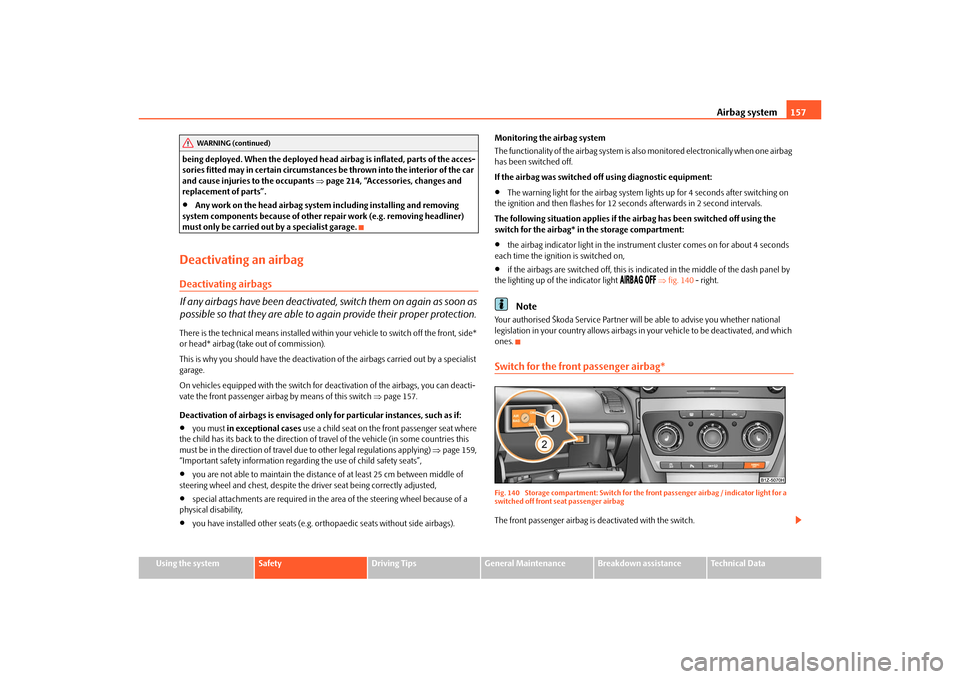
Airbag system157
Using the system
Safety
Driving Tips
General Maintenance
Breakdown assistance
Technical Data
being deployed. When the deployed head airbag is inflated, parts of the acces-
sories fitted may in certain circumstances be thrown into the interior of the car
and cause injuries to the occupants
page 214, “Accessories, changes and
replacement of parts”.
Any work on the head airbag system including installing and removing
system components because of other repair work (e.g. removing headliner)
must only be carried out by a specialist garage.
Deactivating an airbagDeactivating airbags
If any airbags have been deactivated, switch them on again as soon as
possible so that they are able to again provide their proper protection.There is the technical means installed within your vehicle to switch off the front, side*
or head* airbag (take out of commission).
This is why you should have the deactivation of the airbags carried out by a specialist
garage.
On vehicles equipped with the switch for de activation of the airbags, you can deacti-
vate the front passenger airbag by means of this switch page 157.
Deactivation of airbags is envisaged only for particular instances, such as if:
you must in exceptional cases use a child seat on the front passenger seat where
the child has its back to the direction of tr avel of the vehicle (in some countries this
must be in the direction of travel due to other legal regulations applying) page 159,
“Important safety information regarding the use of child safety seats”,
you are not able to maintain the distan ce of at least 25 cm between middle of
steering wheel and chest, despite the driver seat being correctly adjusted,
special attachments are required in the ar ea of the steering wheel because of a
physical disability,
you have installed other seats (e.g. orthopaedic seats without side airbags). Monitoring the airbag system
The functionality of the airbag system is al
so monitored electronically when one airbag
has been switched off.
If the airbag was switched off using diagnostic equipment:
The warning light for the airbag system li ghts up for 4 seconds after switching on
the ignition and then flashes for 12 seconds afterwards in 2 second intervals.
The following situation applies if the ai rbag has been switched off using the
switch for the airbag* in the storage compartment:
the airbag indicator light in the instrume nt cluster comes on for about 4 seconds
each time the igniti on is switched on,
if the airbags are switched off, this is in dicated in the middle of the dash panel by
the lighting up of the indicator light
fig. 140 - right.
Note
Your authorised Škoda Service Partner will be able to advise you whether national
legislation in your country allows airbags in your vehicle to be deactivated, and which
ones.Switch for the front passenger airbag*Fig. 140 Storage compartment: Switch for the front passenger airbag / indicator light for a
switched off front seat passenger airbagThe front passenger airbag is deactivated with the switch.
WARNING (continued)
s43s.1.book Page 157 Thursday, May 13, 2010 1:21 PM
Page 161 of 275
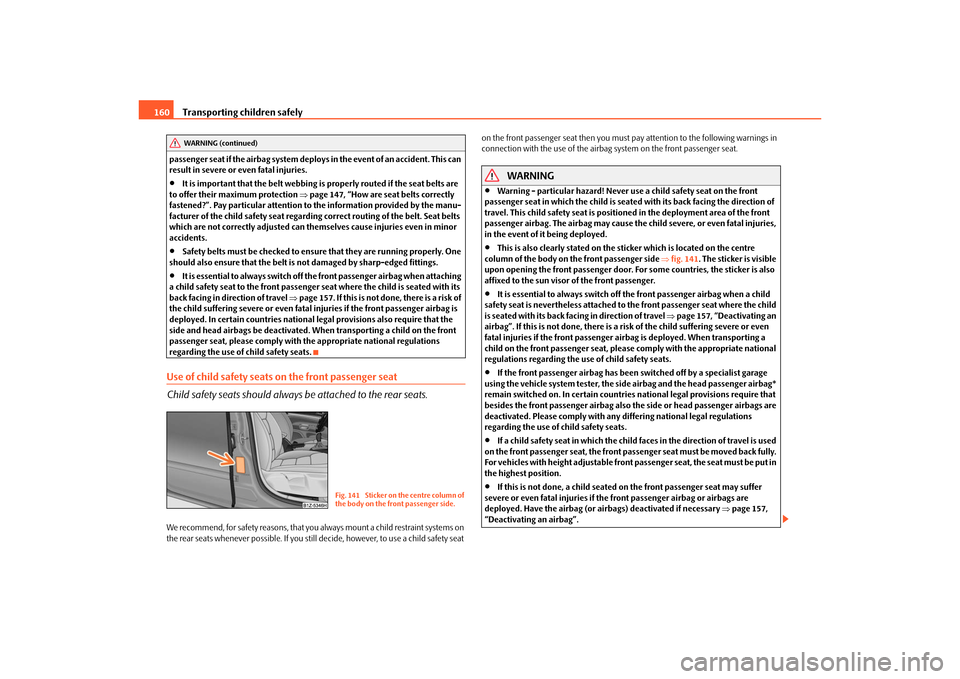
Transporting children safely
160
passenger seat if the airbag system deploy s in the event of an accident. This can
result in severe or even fatal injuries.
It is important that the belt webbing is properly routed if the seat belts are
to offer their maximum protection page 147, “How are seat belts correctly
fastened?”. Pay particular attention to the information provided by the manu-
facturer of the child safety seat regarding correct routing of the belt. Seat belts
which are not correctly adjusted can themselves cause injuries even in minor
accidents.
Safety belts must be checked to ensure that they are running properly. One
should also ensure that the belt is not damaged by sharp-edged fittings.
It is essential to always switch off th e front passenger airbag when attaching
a child safety seat to the front passenger seat where the child is seated with its
back facing in direction of travel page 157. If this is not done, there is a risk of
the child suffering severe or even fatal in juries if the front passenger airbag is
deployed. In certain countries national legal provisions also require that the
side and head airbags be deactivated. When transporting a child on the front
passenger seat, please comply with the appropriate national regulations
regarding the use of child safety seats.
Use of child safety seats on the front passenger seat
Child safety seats should always be attached to the rear seats.We recommend, for safety reasons, that you always mount a child restraint systems on
the rear seats whenever possible. If you still decide, however, to use a child safety seat on the front passenger seat then you must pay attention to the following warnings in
connection with the use of the airbag
system on the front passenger seat.
WARNING
Warning - particular hazard! Never use a child safety seat on the front
passenger seat in which the child is seated with its back facing the direction of
travel. This child safety seat is positioned in the deployment area of the front
passenger airbag. The airbag may cause th e child severe, or even fatal injuries,
in the event of it being deployed.
This is also clearly stated on the sticker which is located on the centre
column of the body on the front passenger side fig. 141 . The sticker is visible
upon opening the front pass enger door. For some countri es, the sticker is also
affixed to the sun visor of the front passenger.
It is essential to always switch off the front passenger airbag when a child
safety seat is nevertheless attached to the front passenger seat where the child
is seated with its back facing in direction of travel page 157, “Deactivating an
airbag”. If this is not done, there is a risk of the child suffering severe or even
fatal injuries if the front passenger airbag is deployed. When transporting a
child on the front passenger seat, please comply with the appropriate national
regulations regarding the use of child safety seats.
If the front passenger airbag has been switched off by a specialist garage
using the vehicle system tester, the side airbag and the head passenger airbag*
remain switched on. In certain countries national legal provisions require that
besides the front passenger airbag also the side or head passenger airbags are
deactivated. Please comply with any differing national legal regulations
regarding the use of child safety seats.
If a child safety seat in which the child faces in the direction of travel is used
on the front passenger seat, the front pass enger seat must be moved back fully.
For vehicles with height adjustable front passenger seat, the seat must be put in
the highest position.
If this is not done, a child seated on the front passenger seat may suffer
severe or even fatal injuries if the front passenger airbag or airbags are
deployed. Have the airbag (or airbags) deactivated if necessary page 157,
“Deactivating an airbag”.
WARNING (continued)
Fig. 141 Sticker on the centre column of
the body on the front passenger side.
s43s.1.book Page 160 Thursday, May 13, 2010 1:21 PM
Page 162 of 275
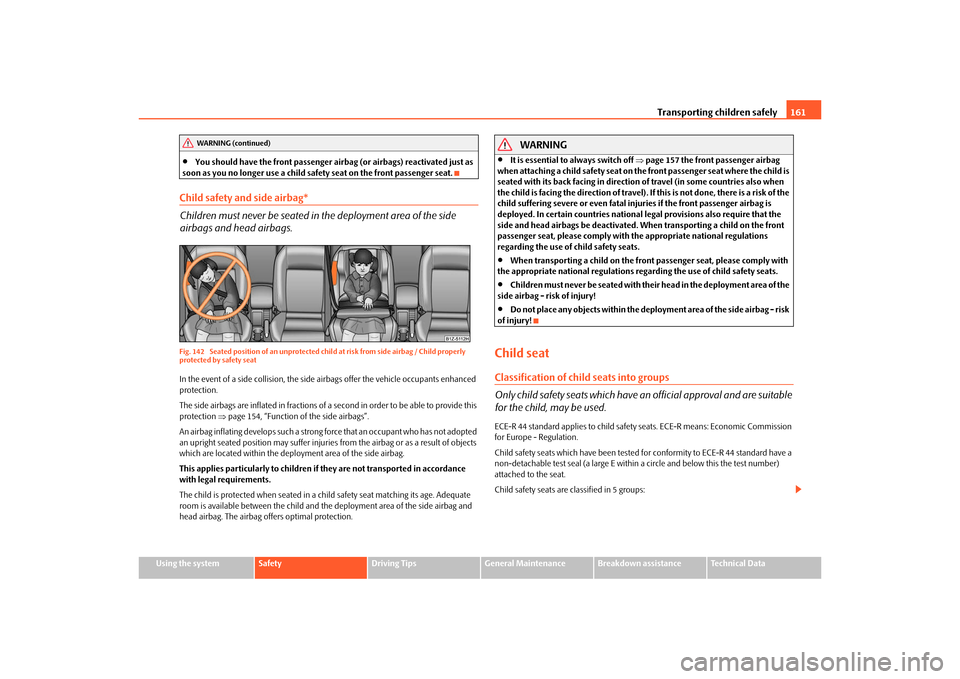
Transporting children safely161
Using the system
Safety
Driving Tips
General Maintenance
Breakdown assistance
Technical Data
You should have the front passenger airbag (or airbags) reactivated just as
soon as you no longer use a child safe ty seat on the front passenger seat.
Child safety and side airbag*
Children must never be seated in the deployment area of the side
airbags and head airbags.Fig. 142 Seated position of an unprotected chil d at risk from side airbag / Child properly
protected by safety seatIn the event of a side collision, the side ai rbags offer the vehicle occupants enhanced
protection.
The side airbags are inflated in fractions of a second in order to be able to provide this
protection page 154, “Function of the side airbags”.
An airbag inflating develops such a strong force that an occupant who has not adopted
an upright seated position may suffer injuries from the airbag or as a result of objects
which are located within the deployment area of the side airbag.
This applies particularly to children if they are not transported in accordance
with legal requirements.
The child is protected when seated in a chil d safety seat matching its age. Adequate
room is available between the child and the deployment area of the side airbag and
head airbag. The airbag offers optimal protection.
WARNING
It is essential to always switch off page 157 the front passenger airbag
when attaching a child safety seat on th e front passenger seat where the child is
seated with its back facing in direction of travel (in some countries also when
the child is facing the direction of travel). If this is not done, there is a risk of the
child suffering severe or even fatal inju ries if the front passenger airbag is
deployed. In certain countries national legal provisions also require that the
side and head airbags be deactivated. When transporting a child on the front
passenger seat, please comply with the appropriate national regulations
regarding the use of child safety seats.
When transporting a child on the front passenger seat, please comply with
the appropriate national regulations r egarding the use of child safety seats.
Children must never be seated with thei r head in the deployment area of the
side airbag - risk of injury!
Do not place any objects within the deployment area of the side airbag - risk
of injury!
Child seatClassification of child seats into groups
Only child safety seats which have an official approval and are suitable
for the child, may be used.ECE-R 44 standard applies to child safety seats. ECE-R means: Economic Commission
for Europe - Regulation.
Child safety seats which have been tested for conformity to ECE-R 44 standard have a
non-detachable test seal (a large E within a circle and below this the test number)
attached to the seat.
Child safety seats are classified in 5 groups:
WARNING (continued)
s43s.1.book Page 161 Thursday, May 13, 2010 1:21 PM
Page 163 of 275
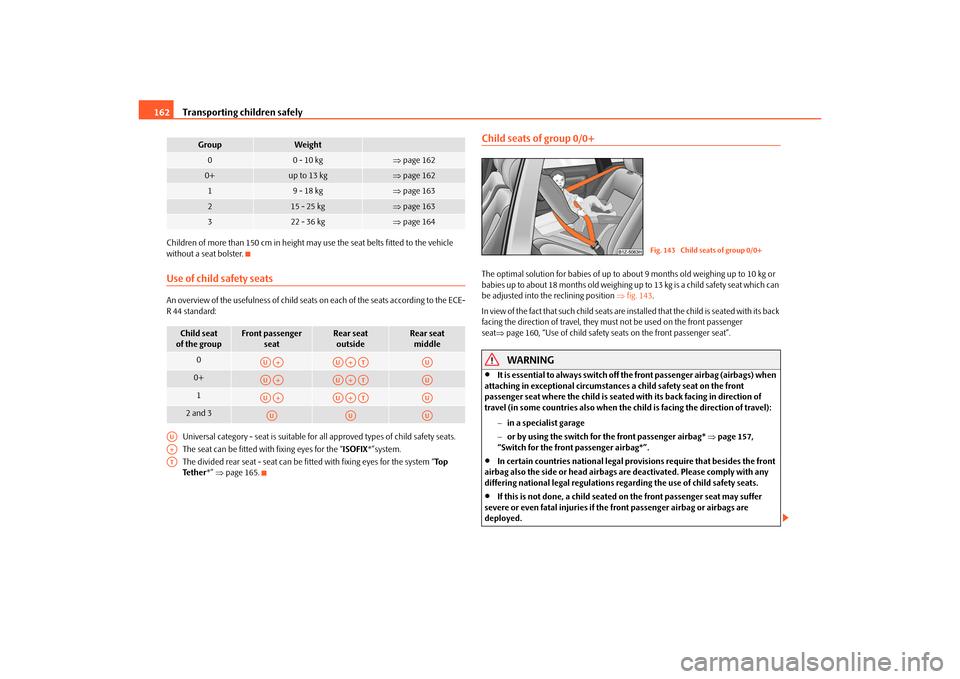
Transporting children safely
162
Children of more than 150 cm in height may use the seat belts fitted to the vehicle
without a seat bolster.Use of child safety seatsAn overview of the usefulness of child seats on each of the seats according to the ECE-
R44 standard:
Universal category - seat is suitable for all approved types of child safety seats.
The seat can be fitted with fixing eyes for the “ ISOFIX*”system.
The divided rear seat - seat can be fitt ed with fixing eyes for the system “To p
Te t h e r *” page 165.
Child seats of group 0/0+The optimal solution for babies of up to about 9 months old weighing up to 10 kg or
babies up to about 18 months old weighing up to 13 kg is a child safety seat which can
be adjusted into the reclining position fig. 143 .
In view of the fact that such child seats are installed that the child is seated with its back
facing the direction of travel, they mu st not be used on the front passenger
seat page 160, “Use of child safety se ats on the front passenger seat”.
WARNING
It is essential to always switch off th e front passenger airbag (airbags) when
attaching in exceptional circumstances a child safety seat on the front
passenger seat where the child is seated with its back facing in direction of
travel (in some countries also when the child is facing the direction of travel):
in a specialist garage
or by using the switch for the front passenger airbag* page 157,
“Switch for the front passenger airbag*”.
In certain countries national legal provisions require that besides the front
airbag also the side or head airbags ar e deactivated. Please comply with any
differing national legal r egulations regarding the use of child safety seats.
If this is not done, a child seated on the front passenger seat may suffer
severe or even fatal injuries if the front passenger airbag or airbags are
deployed.
Group
Weight
0
0 - 10 kg
page 162
0+
up to 13 kg
page 162
1
9 - 18 kg
page 163
2
15 - 25 kg
page 163
3
22 - 36 kg
page 164
Child seat
of the group
Front passenger seat
Rear seat outside
Rear seat middle
0
0+
1
2 and 3
AUA+
AUA+AT
AU
AUA+
AUA+AT
AU
AUA+
AUA+AT
AU
AU
AU
AU
AUA+AT
Fig. 143 Child seats of group 0/0+
s43s.1.book Page 162 Thursday, May 13, 2010 1:21 PM
Page 164 of 275
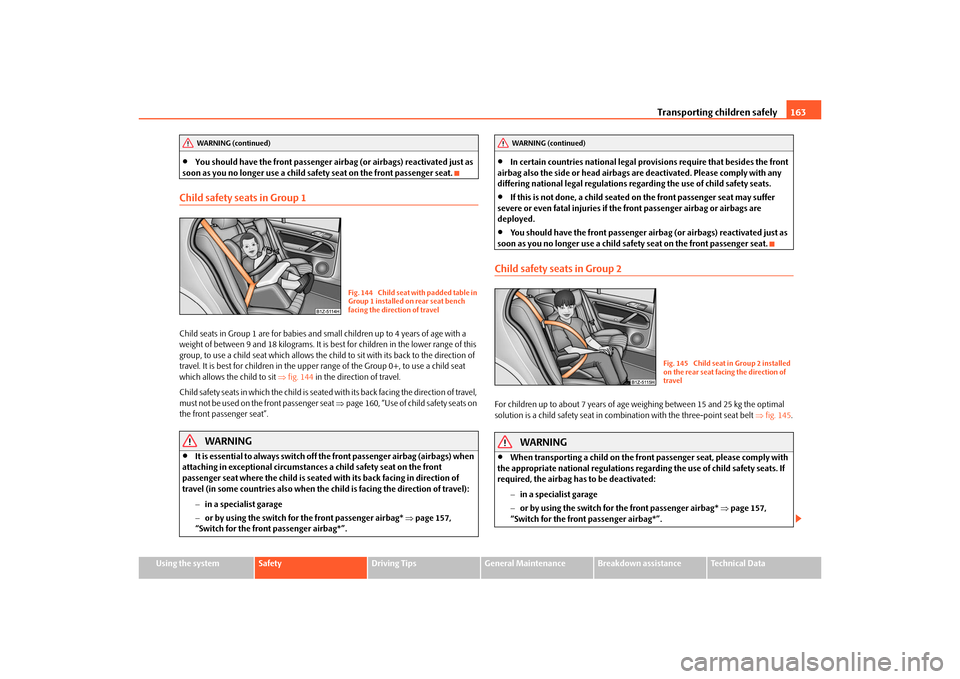
Transporting children safely163
Using the system
Safety
Driving Tips
General Maintenance
Breakdown assistance
Technical Data
You should have the front passenger airbag (or airbags) reactivated just as
soon as you no longer use a child safe ty seat on the front passenger seat.
Child safety seats in Group 1Child seats in Group 1 are for babies and small children up to 4 years of age with a
weight of between 9 and 18 kilograms. It is best for children in the lower range of this
group, to use a child seat which allows the ch ild to sit with its back to the direction of
travel. It is best for children in the uppe r range of the Group 0+, to use a child seat
which allows the child to sit fig. 144 in the direction of travel.
Child safety seats in which the child is seated with its back facing the direction of travel,
must not be used on the front passenger seat page 160, “Use of child safety seats on
the front passenger seat”.
WARNING
It is essential to always switch off th e front passenger airbag (airbags) when
attaching in exceptional circumstances a child safety seat on the front
passenger seat where the child is seated with its back facing in direction of
travel (in some countries also when the child is facing the direction of travel):
in a specialist garage
or by using the switch for the front passenger airbag* page 157,
“Switch for the front passenger airbag*”.
In certain countries national legal provisions require that besides the front
airbag also the side or head airbags ar e deactivated. Please comply with any
differing national legal r egulations regarding the use of child safety seats.
If this is not done, a child seated on the front passenger seat may suffer
severe or even fatal injuries if the front passenger airbag or airbags are
deployed.
You should have the front passenger airbag (or airbags) reactivated just as
soon as you no longer use a child safe ty seat on the front passenger seat.
Child safety seats in Group 2For children up to about 7 years of age weighing between 15 and 25 kg the optimal
solution is a child safety seat in combination with the three-point seat belt fig. 145 .
WARNING
When transporting a child on the front passenger seat, please comply with
the appropriate national regulations regard ing the use of child safety seats. If
required, the airbag has to be deactivated:
in a specialist garage
or by using the switch for the front passenger airbag* page 157,
“Switch for the front passenger airbag*”.
WARNING (continued)
Fig. 144 Child seat with padded table in
Group 1 installed on rear seat bench
facing the direction of travel
WARNING (continued)
Fig. 145 Child seat in Group 2 installed
on the rear seat facing the direction of
travel
s43s.1.book Page 163 Thursday, May 13, 2010 1:21 PM
Page 165 of 275
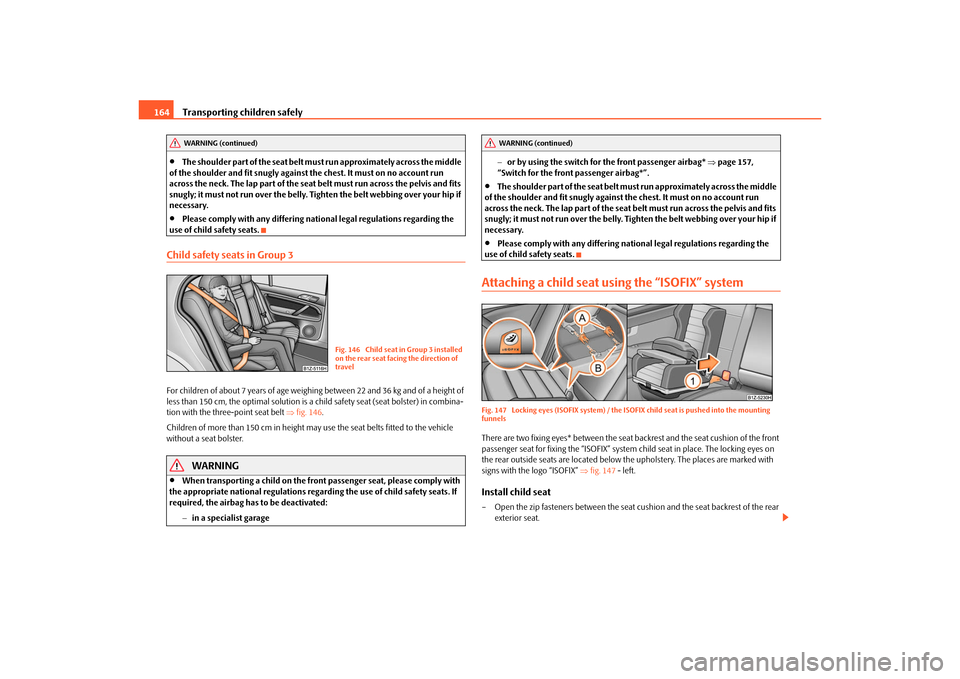
Transporting children safely
164
The shoulder part of the seat belt mu st run approximately across the middle
of the shoulder and fit snugly against the chest. It must on no account run
across the neck. The lap part of the seat belt must run across the pelvis and fits
snugly; it must not run over the belly. Tighten the belt webbing over your hip if
necessary.
Please comply with any differing nati onal legal regulations regarding the
use of child safety seats.
Child safety seats in Group 3For children of about 7 years of age weighing between 22 and 36 kg and of a height of
less than 150 cm, the optimal solution is a ch ild safety seat (seat bolster) in combina-
tion with the three-point seat belt fig. 146 .
Children of more than 150 cm in height may use the seat belts fitted to the vehicle
without a seat bolster.
WARNING
When transporting a child on the front passenger seat, please comply with
the appropriate national regu lations regarding the use of child safety seats. If
required, the airbag has to be deactivated:
in a specialist garage
or by using the switch for the front passenger airbag* page 157,
“Switch for the front passenger airbag*”.
The shoulder part of the seat belt mu st run approximately across the middle
of the shoulder and fit snugly against the chest. It must on no account run
across the neck. The lap part of the seat belt must run across the pelvis and fits
snugly; it must not run over the belly. Tighten the belt webbing over your hip if
necessary.
Please comply with any differing nati onal legal regulations regarding the
use of child safety seats.
Attaching a child seat using the “ISOFIX” systemFig. 147 Locking eyes (ISOFIX system) / the IS OFIX child seat is pushed into the mounting
funnelsThere are two fixing eyes* between the seat backrest and the seat cushion of the front
passenger seat for fixing the “ISOFIX” system child seat in place. The locking eyes on
the rear outside seats are located below th e upholstery. The places are marked with
signs with the logo “ISOFIX” fig. 147 - left.Install child seat– Open the zip fasteners between the seat cushion and the seat backrest of the rear
exterior seat.
WARNING (continued)
Fig. 146 Child seat in Group 3 installed
on the rear seat facing the direction of
travel
WARNING (continued)
s43s.1.book Page 164 Thursday, May 13, 2010 1:21 PM